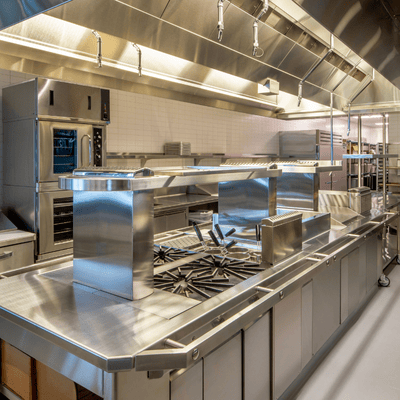Is Mold Secretly Hurting Your Restaurant? Here’s What You Need to Know

Picture this: A customer walks into your restaurant, expecting a delicious meal—but instead, they catch a musty smell in the air. Maybe they spot some discoloration near the ceiling or, worse, they leave with more than just a full stomach—cue the health department knocking on your door.
Mold in restaurants isn’t just an aesthetic issue; it’s a full-blown business risk. It can contaminate food, lead to health violations, and send customers running for the exit. In severe cases, it can even result in fines, temporary closures, or legal action.
And with moisture-rich environments like kitchens, storage areas, and walk-in coolers, restaurants are a prime breeding ground for mold.
But don’t panic just yet. With the right knowledge, you can prevent mold growth, stay compliant with health regulations, and protect both your customers and your business.
This guide will walk you through how to spot mold before it becomes a problem, what to do if you find it, and how to keep your restaurant safe, clean, and thriving.
The Hidden Dangers: Why Mold in Restaurants Is a Major Threat
Mold can be lurking where you least expect it. You might think mold is only a problem in abandoned buildings or damp basements, but restaurants are actually prime breeding grounds.
Why?
Because kitchens have the perfect combination of heat, moisture, and organic material (aka food particles) to help mold thrive. Here’s what might be fueling the problem in your establishment:
Here’s what might be fueling the problem in your establishment:
- Hidden Leaks – Pipes under sinks, dishwashers, and refrigeration units often develop slow leaks that go unnoticed.
- Condensation Issues – Walk-in coolers and freezer units produce moisture buildup, creating a perfect mold-friendly environment.
- Poor Ventilation – If your restaurant has inadequate airflow, humidity levels can rise, encouraging mold growth.
- Neglected Cleaning Areas – Hard-to-reach places, like behind appliances and under shelving, can collect moisture and food debris.
Aside from being unsightly, mold poses serious health risks:
- Respiratory issues and allergic reactions in customers and employees.
- Food contamination, leading to potential foodborne illness.
- Toxic black mold exposure, which can cause severe health complications.
If a health inspector spots mold in your kitchen, you could be hit with fines—or worse, a temporary shutdown. That’s why staying ahead of the problem is critical.
Regulatory Compliance: What Health Inspectors Look For

Health inspectors are trained to detect mold risks and other sanitation issues. Here’s what they’ll be watching for:
- Visible mold on walls, ceilings, or food storage areas.
- Signs of excess moisture (leaky pipes, condensation buildup, standing water).
- Unsanitary food storage practices that encourage mold growth.
- Poor ventilation or HVAC problems contributing to humidity issues.
- Inconsistent cleaning routines in moisture-prone areas.
Failing an inspection due to mold can result in:
- Costly fines and penalties.
- A damaged reputation (negative reviews, loss of customer trust).
- Temporary or permanent business closure if issues go unresolved.
Staying compliant means proactive inspections and routine maintenance to ensure mold doesn’t have a chance to grow.
Prevention First: How to Keep Mold Out of Your Kitchen and Dining Areas
Prevention is key when it comes to mold in restaurants. Here’s how to stay ahead of the problem:
- Fix leaks ASAP – Check under sinks, behind dishwashers, and near ice machines weekly. Any small leak can become a mold hotspot.
- Control humidity – Keep humidity between 30-50%. Use hygrometers to monitor levels in storage rooms, kitchens, and restrooms.
- Deep-clean mold-prone areas – Schedule weekly deep cleaning for refrigeration units, under sinks, and behind cooking stations.
- Improve ventilation – Ensure kitchen exhaust fans work efficiently and staff keep dry storage areas ventilated.
- Store food properly – Keep perishables in clean, dry conditions to prevent mold contamination.
Signs of Trouble: How to Detect Mold Before It Becomes a Crisis
Catching mold early can save you from a full-blown disaster. Be on the lookout for:
Musty odors – A persistent, damp smell means mold could be growing out of sight.
Discoloration – Dark spots on walls, ceilings, or storage areas are often mold indicators.
Increased allergy symptoms – If employees or customers report sneezing, coughing, or itchy eyes, mold could be the culprit.
Standing water – Puddles or condensation buildup indicate a high-risk mold area.
How to Stay Ahead:
- Daily Staff Check – Train employees to report musty smells or unusual stains.
- Weekly Deep Clean – Inspect areas prone to moisture buildup every week.
- Quarterly Professional Inspection – Have a mold expert check ventilation, hidden leaks, and high-risk zones every three months.
Read more: CDC- Workplace Mold and Your Health
Damage Control: What to Do If You Discover Mold in Your Restaurant
If you’ve found mold, take action immediately:
1. Isolate the Area – Immediately block off the contaminated area to prevent cross-contamination.
2. Document the Issue – Take clear photos and notes for insurance and health inspection records.
3. Schedule a Professional Inspection – Contact Howard Environmental for expert mold testing and assessment.
4. Plan for Remediation – If the mold is extensive, schedule remediation ASAP to avoid further health risks.
5. Prevent Future Growth – Identify and fix the root cause (leaks, ventilation issues, etc.) to prevent recurring mold problems.
Protect Your Business: Long-Term Strategies to Stay Mold-Free
Winning Strategies for a Mold-Free Restaurant:
- Upgrade to mold-resistant materials – Use mold-resistant paint, stainless steel, and sealed flooring in kitchens.
- Invest in Smart Humidity Sensors – Install automatic moisture sensors to alert you to rising humidity levels.
- Set a Cleaning SOP (Standard Operating Procedure) – Create a restaurant cleaning checklist that includes mold-prone areas.
- Educate Your Staff – Train employees on mold prevention so they can spot early warning signs before it becomes a bigger issue.
Final Verdict: Protect Your Restaurant Before It’s Too Late
Keeping your restaurant mold-free isn’t just about avoiding fines—it’s about ensuring your customers feel safe, your staff stays healthy, and your business thrives.
Don’t wait until an inspector finds mold. Take control now.
Book a professional mold inspection with Howard Environmental today and get ahead of potential problems before they cost you customers, money, or your business.
Call Howard Environmental today at (737) 285-4370 or schedule an inspection here.
Your customers (and your bottom line) will thank you for it.

